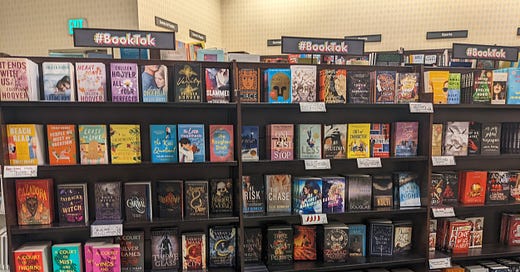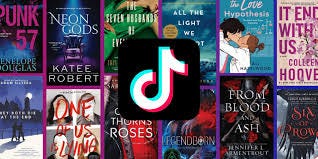You’ve likely heard of BookTok, the subcommunity with 200 billion views of TikTokers discussing books… or, at least that’s what it used to be.
Originally, BookTok had a small, wholesome following that mostly consisted of fans of classic literature, Harry Potter or Percy Jackson, and the occasional Lord of the Rings nerd, but during the pandemic, it blew up because a younger audience brought in their favorite genres: romance and fantasy. Initially, there was a diverse selection of genres from world literature to magical realism, but now, there’s a specific type of book that’s piqued the public’s interest—the BookTok book. These books gained immense popularity on TikTok, with communities discussing their content, creating fanart/fanficition, aesthetics inspired off of the book, and selling candles on Etsy inspired by the supposed scent of characters. The most popular books tend to be young adult romances with elements of stereotypical European fantasy (Arthurian dragons, Tolkien-esque elves, and long-lost wizards), often making use of tropes like “enemies to lovers” or “there’s only one bed”.
One book, for example, is the romance-fantasy series, A Court of Thorns and Roses by Sara J. Maas, which had sold 13 million copies in just one year. It tells the story of a young peasant girl named Feyre who gets stolen away to a parallel world by a mysterious hot faerie prince.
I mean, it’s not exactly Dante traveling down to the depths of Hell in spiritual discovery, but it’s fine… until you actually read the book.
Last year, my friend lent me the first book in Maas’ series and promised me that it would be a beautiful read and that the relationship between Feyre and her love interest would become one of my favorites.
Unfortunately, it did not live up to the hype. The world seemed too artificial, every character had a predictable sob story, the main character was extremely helpless but framed as “strong”, and, the most alarming— the supposed “romantic” men were frankly abusive. Feyre’s first love interest (the mysterious hot faerie prince), Tamlin, is described as having long, shiny blonde hair, chiseled cheekbones, and a tragic backstory that makes up for the time he raped the main character under the influence of magic (the tone that the main character describes the assault as sensual and romantic, which, ya know, IS A RED FLAG). The other love interest is Rhysand, another mysterious hot faerie prince with a dark backstory (in fact, his backstory is so dark that he’s the prince of the Night Court) who initially appears as an antagonist, but later in the series, the two get married and have a child. The issue with him is that in the first book, Rhysand gets the main character drunk in order to have his way with her and constantly objectifies and makes unwanted crude comments towards her. Near the climax of the first book, while the main character is imprisoned for somewhat complicated reasons, Rhysand comes over to taunt her, physically beat her, and then LICKS HER TEARS.
Um, WHAT?!
The audience consuming this book mostly consists of adolescent girls and young women that are trying to find models for a healthy relationship. Is this what they’re trying to teach my generation of girls? That it’s okay to be abused and mocked by their partners? (Also, I urge you to look up fanart of both Rhysand and Tamlin and try your best to be seduced by their appearance).
The obsession on BookTok with men doesn’t stop there.
One trend portrays clips of girls on BookTok demanding that all fictional male love interests be tall, dark-haired and possessing morally gray behavior. But, Captain Hook also checks these boxes, and I bet you aren’t going to buy a book about him as a love interest (Whoops, never mind. There actually is a BookTok book with Captain Hook as the love interest. It’s called Hooked… very clever).
Meanwhile, another subcommunity called BikeTok (men curating TikToks about everything related to motorcycles) claims to “own the BookTok girls.” These men claim to resemble the love interests found in popular dark romance novels such as one BookTok book called Haunting Adeline (about a man who stalks and rapes the female main character with a gun… WHO IS PUBLISHING THESE BOOKS AND CALLING THEM ROMANCE???). The issue is that these dark romance novels deal with violent topics. Disturbingly, these creators make posts about raping or kidnapping BookTok girls, even staging videos where masked men on motorcycles leave trails of romance books “to catch BookTok girls.” From this, a new subcommunity has emerged called MaskTok and mostly features men with the Ghostface mask from Scream creating suggestive content about sexually assaulting the viewer.
But regardless of the morality of these trends, the publishing industry has been swayed by BookTok to change what it feeds to the minds of readers. First is the emergence of the new genre of “Romantasy” (romance and fantasy), which you can immediately spot out with this rule: It’s Romantasy if the title has the words “blood,” “ash,” “bone” or anything royalty-adjacent (examples of real books: From Blood and Ash, Shadow and Bone, House of Earth and Blood, Queen of Shadows).
Second, we need to examine books branded with “strong females.” If we look closely, these women are praised for their violence, refusal to express emotion, arrogance and aggression. Authors are taking the very traits we dislike in men and placing it in their women! Not only does this send out the message that women need to act more traditionally masculine to appear strong but it also suggests that emotion reveals weakness.
The third, and possibly the most important, is that there is no deeper meaning in these books. They don’t have us thinking, wondering or questioning. I mean, after you’ve read 500 pages of Twilight, what secret of the universe have you unlocked?
These books are reminiscent of the behaviors portrayed in Fahrenheit 451 by Ray Bradbury where media became fast-paced and less profound; that just to sit down with a classic book is hefty exercise for the mind.
You can see this in our media (Gossip Girl, Keeping Up With the Kardashians, the Real Housewives of whatever random city is next?), our shorter attention spans (8.25 seconds), and our language (why is Gen Alpha saying “Skibidi” or “rizz”?). We want a quick message, instant gratification, and a hustle lifestyle. I mean, how many of us watch something while we’re brushing our teeth because God forbid we’re bored and have to face our thoughts?
This is NOT to judge or bash anybody who is reading these books, but as a member of the target generation for these publishers, we deserve to have books that are not just for entertainment, but also cause us to think, to learn, and to remember something it seems we have forgotten.
So, if you’re also tired of walking into a Barnes & Nobles and only being confronted with elfish men and their “darkened eyes”, here are some suggestions for something different:
Instead of [BookTok book] try…
Shatter Me---------------------------------------------------------Cloud Atlas (David Mitchell)
Red Queen--------------------------------------------------Midnight’s Children (Salman Rushdie)
November 9th—————————————————————--The Bell Jar (Sylvia Plath)
A Court of Thorns and Roses-------------------The Master and Margarita (Mikhail Bulgakov)
Fourth Wing-----------------American Gods, The Ocean At the End of the Lane (Neil Gaiman)
From Blood and Ash--------------------------------Paradise Rot, Girls Against God (Jenny Hval)
The Twisted Series---------------------------------Cleopatra and Frankenstein (Coco Mellors)
People We Meet on Vacation-------------------------The Island of Missing Trees (Elif Shafak)
Icebreaker——————————————————————- Paradise Lost (John Milton)
Verity—————————————————————— The Blind Owl (Sadegh Hedayat)
It Ends With Us———————————————Kafka on the Shore (Haruki Murakami)
The Love Hypothesis——————————————————The Kalevala (Finnish Epic)
Keep telling and collecting stories,
Ava Behjat






It's so refreshing to hear the ACOTAR slander. It brings me so much joy. I loved the substitute recommendations also. Thank you for this!
I think good art captivates its audience, but great art challenges its audience, and in that tension the recipient of the art, whatever form it takes, has an opportunity to struggle with something deep within themselves that they might not even realize is there.
Your piece does a wonderful job of identifying the inherent difference between good and great, and the way you give alternatives to what are probably good books, with great ones, that was… great. 🥰